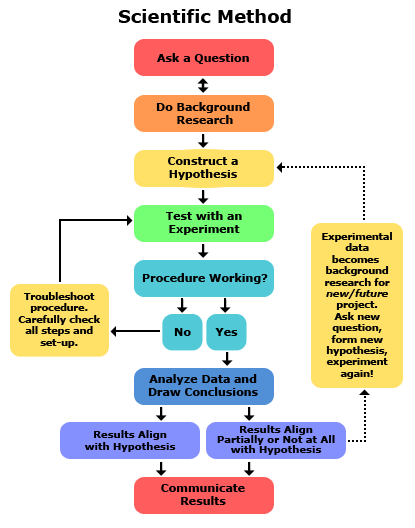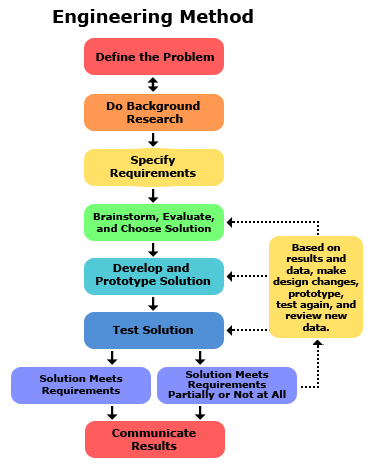Comparing the Engineering Design Process and the Scientific Method
While scientists study how nature works, engineers create new things, such as products, websites, environments, and experiences. Because engineers and scientists have different objectives, they follow different processes in their work. Scientists perform experiments using the scientific method; whereas, engineers follow the creativity-based engineering design process.
Both processes can be broken down into a series of steps, as seen in the diagram and table.
 Image Credit: created by Amy Cowen for Science Buddies / Science Buddies
Image Credit: created by Amy Cowen for Science Buddies / Science BuddiesDiagram of the Scientific Method. The scientific method starts with a question, and background research is conducted to try to answer that question. If you want to find evidence for an answer, or an answer itself, you construct a hypothesis and test that hypothesis in an experiment. If the experiment works and the data is analyzed you can either prove or disprove your hypothesis. If your hypothesis is disproved, then you can go back with the new information gained and create a new hypothesis to start the scientific process over again.
 Image Credit: created by Amy Cowen for Science Buddies / Science Buddies
Image Credit: created by Amy Cowen for Science Buddies / Science BuddiesThe engineering design process begins by defining a problem and completing background research on the problem. Requirements are specified and a solution is chosen. A prototype of the solution is built and then tested. If the solution built meets the requirements then the results can be shared. If the solution does not meet all the requirements then another solution is thought of and tested. Each iteration should use the data from the previously tried solution to meet all of the initial requirements.
| The Scientific Method | The Engineering Design Process |
| State your question | Define the problem |
| Do background research | Do background research |
| Formulate your hypothesis, identify variables | Specify requirements |
| Design experiment, establish procedure | Create alternative solutions, choose the best one and develop it |
| Test your hypothesis by doing an experiment | Build a prototype |
| Analyze your results and draw conclusions | Test and redesign as necessary |
| Communicate results | Communicate results |
| Steps of The Scientific Method | Steps of The Engineering Design Process |
Keep in mind that although the steps are listed in sequential order, you will likely return to previous steps multiple times throughout a project. It is often necessary to revisit stages or steps in order to improve that aspect of a project.
You can see the steps of each process in these flowcharts:
Why are there two processes?
Both scientists and engineers contribute to the world of human knowledge, but in different ways. Scientists use the scientific method to make testable explanations and predictions about the world. A scientist asks a question and develops an experiment, or set of experiments, to answer that question. Engineers use the engineering design process to create solutions to problems. An engineer identifies a specific need: Who need(s) what because why? And then, he or she creates a solution that meets the need.
Which process should I follow for my project?
Watch the video to see what it looks like to tackle the same topic using the scientific method versus the engineering design process.
In real life, the distinction between science and engineering is not always clear. Scientists often do some engineering work, and engineers frequently apply scientific principles, including the scientific method. Much of what we often call "computer science" is actually engineering—programmers creating new products. Your project may fall in the gray area between science and engineering, and that's OK. Many projects, even if related to engineering, can and should use the scientific method.
However, if the objective of your project is to invent a new product, computer program, experience, or environment, then it makes sense to follow the engineering design process.
Important Note: Most, but not all, science fairs accept engineering projects completed using the engineering design process. Some even encourage it. However, if in doubt, you should check with your fair before you follow the engineering design process instead of the scientific method.





